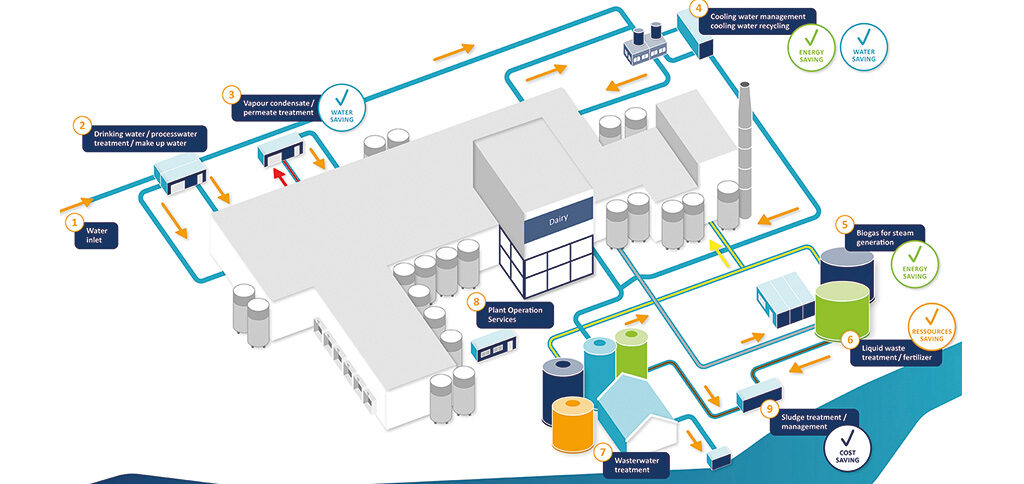Water management in dairies

Water management in dairies and saving resources are not just passing trends in the 2020s. In fact, milk-processing companies, which are notoriously energy and resource intensive, have been working intensively to consistently reduce their energy, packaging, and water consumption for decades. In terms of resource conservation, the milk industry is one of the most advanced industries in the food sector around the world.
The drinktec main topic, Water & Water Management, deals, among other things, with water management in dairies and shows that worldwide, in every dairy, there are two cycles to contend with: drinking water, also called fresh water, and process water. Partly due to legal regulations, but mainly because of its applications, fresh water does not enter into circulation, whereas process water does. This means that the usage of fresh water from the municipal network or from one’s own well is to be kept as low as possible, at all times, to avoid unnecessary costs. This applies both to dry regions due to the prevailing scarcity of water as well as to areas with a more favorable climate, where purchasing and wastewater costs are almost always on the rise to encourage conservation.
If you want a benchmark for water consumption in milk processing, you can use water consumption per kilogram of milk, which currently sits at around 1.3 liters. Overall, this number is getting steadily smaller. The first dairies report that they have been able to reduce it to almost 1.0 liter. These companies can even be found outside of North America, Oceania and the EU – water management in dairies in the Arab and North African regions has also been developed with great effort and meets most modern standards.

Processing MBR waste water
For some time, the Scottish dairy Wiseman, acquired by the Theo Müller group in 2012, has been leading the way in renovating consumer dairy farms in terms of water. Before the project, the Bridgewater company processed 1.25 million liters of milk a day, resulting in around 400 m3 of wastewater that was treated on site and then drained into the outfall. Now, the majority of the water is used for steam generation and cleaning.
According to the UN, water consumption has been increasing by about one percent annually since the 1980s. This rise is fueled by growing populations, socioeconomic development and changing consumption habits. Water demand around the world is expected to continue rising at this level until 2050 – an increase of 20 to 30 percent above today’s consumption levels.
The idea was to pass wastewater that is already crystal clear due to treatment with a membrane bioreactor(MBR) process through a reverse osmosis system. This way, the byproduct can partially replace fresh water. Reverse osmosis produces 200 m³ of water a day, which can be used for cleaning without any issues. Resource conservation protects the environment while increasing sustainability and has measurable value: each year, the Bridgwater dairy saves more than 20,000 pounds.
Water management in dairies using water vapor
Drying systems can achieve an even greater effect using water vapor. Water vapor is the condensation that results from the drying of milk in the production of milk powder and makes up 88% of the milk. This condensate contains natural milk residue, so it requires processing using biological treatment and membrane processes before it can be reused as process water. This water is well suited for cleaning, but, depending on local regulations, is not always allowed for use as fresh water – although as far as quality is concerned, there is no reason to forbid it.
Holistic view of production processes
MBR wastewater and water vapor are only two topics outlining the complexity of water management in dairies. Ideally, all steps in the operation will be analyzed to determine what quality of water can be used at what stages in the process. The energy contained in wastewater can also be used in the heat exchange to improve the overall energy balance of a milk factory. This turns organic material contained in wastewater from waste into valuable raw material for generating energy, since it can be converted in a reactor into biogas.
The effects that intelligent water management and water processing have on a dairy differ from company to company. Yet, the overall result is always cost savings and increased sustainability. Those hoping to gain an overview of modern water management and water processing will discover all the latest information at drinktec, from September 12 to 16, 2022, at Messe München. Are you still looking for a platform to introduce your innovation to the beverage industry? Then join us at the next drinktec in 2022.
